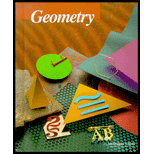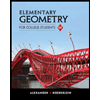
McDougal Littell Jurgensen Geometry: Student Edition Geometry
5th Edition
ISBN: 9780395977279
Author: Ray C. Jurgensen, Richard G. Brown, John W. Jurgensen
Publisher: Houghton Mifflin Company College Division
expand_more
expand_more
format_list_bulleted
Concept explainers
Question
Chapter E, Problem 13.7EX
To determine
To find the equation of line passing through (−3, 5) and (2, 8) .
Expert Solution & Answer
Answer to Problem 13.7EX
Option (b)
Explanation of Solution
Given information: Points (−3, 5) and (2, 8) .
Concept used:
The equation of line passing through (x1,y1) and (x2,y2) is
y−y1=(y2−y1x2−x1)(x−x1)
The equation of line passing through (−3, 5) and (2, 8) is
y−5=(8−52+3)(x+3)y−5=35(x+3)5y−25=3x+93x−5y+34=0
The equation of the line is 3x−5y=−34
y−7=−32(x+4)y=−32x+1
Hence, the equation of line is y=−32x+1
Chapter E Solutions
McDougal Littell Jurgensen Geometry: Student Edition Geometry
Ch. E - Prob. 1.1EXCh. E - Prob. 1.2EXCh. E - Prob. 1.3EXCh. E - Prob. 1.4EXCh. E - Prob. 1.5EXCh. E - Prob. 1.6EXCh. E - Prob. 1.7EXCh. E - Prob. 1.8EXCh. E - Prob. 1.9EXCh. E - Prob. 1.10EX
Ch. E - Prob. 1.11EXCh. E - Prob. 2.1EXCh. E - Prob. 2.2EXCh. E - Prob. 2.3EXCh. E - Prob. 2.4EXCh. E - Prob. 2.5EXCh. E - Prob. 2.6EXCh. E - Prob. 2.7EXCh. E - Prob. 2.8EXCh. E - Prob. 2.9EXCh. E - Prob. 2.10EXCh. E - Prob. 2.11EXCh. E - Prob. 3.1EXCh. E - Prob. 3.2EXCh. E - Prob. 3.3EXCh. E - Prob. 3.4EXCh. E - Prob. 3.5EXCh. E - Prob. 3.6EXCh. E - Prob. 3.7EXCh. E - Prob. 3.8EXCh. E - Prob. 3.9EXCh. E - Prob. 3.10EXCh. E - Prob. 3.11EXCh. E - Prob. 3.12EXCh. E - Prob. 3.13EXCh. E - Prob. 4.1EXCh. E - Prob. 4.2EXCh. E - Prob. 4.3EXCh. E - Prob. 4.4EXCh. E - Prob. 4.5EXCh. E - Prob. 4.6EXCh. E - Prob. 4.7EXCh. E - Prob. 4.8EXCh. E - Prob. 4.9EXCh. E - Prob. 4.10EXCh. E - Prob. 4.11EXCh. E - Prob. 4.12EXCh. E - Prob. 4.13EXCh. E - Prob. 4.14EXCh. E - Prob. 5.1EXCh. E - Prob. 5.2EXCh. E - Prob. 5.3EXCh. E - Prob. 5.4EXCh. E - Prob. 5.5EXCh. E - Prob. 5.6EXCh. E - Prob. 5.7EXCh. E - Prob. 5.8EXCh. E - Prob. 5.9EXCh. E - Prob. 5.10EXCh. E - Prob. 5.11EXCh. E - Prob. 5.12EXCh. E - Prob. 6.1EXCh. E - Prob. 6.2EXCh. E - Prob. 6.3EXCh. E - Prob. 6.4EXCh. E - Prob. 6.5EXCh. E - Prob. 6.6EXCh. E - Prob. 6.7EXCh. E - Prob. 6.8EXCh. E - Prob. 6.9EXCh. E - Prob. 6.10EXCh. E - Prob. 6.11EXCh. E - Prob. 7.1EXCh. E - Prob. 7.2EXCh. E - Prob. 7.3EXCh. E - Prob. 7.4EXCh. E - Prob. 7.5EXCh. E - Prob. 7.6EXCh. E - Prob. 7.7EXCh. E - Prob. 7.8EXCh. E - Prob. 7.9EXCh. E - Prob. 7.10EXCh. E - Prob. 7.11EXCh. E - Prob. 7.12EXCh. E - Prob. 8.1EXCh. E - Prob. 8.2EXCh. E - Prob. 8.3EXCh. E - Prob. 8.4EXCh. E - Prob. 8.5EXCh. E - Prob. 8.6EXCh. E - Prob. 8.7EXCh. E - Prob. 8.8EXCh. E - Prob. 8.9EXCh. E - Prob. 8.10EXCh. E - Prob. 8.11EXCh. E - Prob. 8.12EXCh. E - Prob. 9.1EXCh. E - Prob. 9.2EXCh. E - Prob. 9.3EXCh. E - Prob. 9.4EXCh. E - Prob. 9.5EXCh. E - Prob. 9.6EXCh. E - Prob. 9.7EXCh. E - Prob. 9.8EXCh. E - Prob. 9.9EXCh. E - Prob. 9.10EXCh. E - Prob. 9.11EXCh. E - Prob. 9.12EXCh. E - Prob. 9.13EXCh. E - Prob. 9.14EXCh. E - Prob. 10.1EXCh. E - Prob. 10.2EXCh. E - Prob. 10.3EXCh. E - Prob. 10.4EXCh. E - Prob. 10.5EXCh. E - Prob. 10.6EXCh. E - Prob. 10.7EXCh. E - Prob. 10.8EXCh. E - Prob. 10.9EXCh. E - Prob. 10.10EXCh. E - Prob. 10.11EXCh. E - Prob. 10.12EXCh. E - Prob. 11.1EXCh. E - Prob. 11.2EXCh. E - Prob. 11.3EXCh. E - Prob. 11.4EXCh. E - Prob. 11.5EXCh. E - Prob. 11.6EXCh. E - Prob. 11.7EXCh. E - Prob. 11.8EXCh. E - Prob. 11.9EXCh. E - Prob. 11.10EXCh. E - Prob. 11.11EXCh. E - Prob. 11.12EXCh. E - Prob. 11.13EXCh. E - Prob. 11.14EXCh. E - Prob. 11.15EXCh. E - Prob. 11.16EXCh. E - Prob. 12.1EXCh. E - Prob. 12.2EXCh. E - Prob. 12.3EXCh. E - Prob. 12.4EXCh. E - Prob. 12.5EXCh. E - Prob. 12.6EXCh. E - Prob. 12.7EXCh. E - Prob. 12.8EXCh. E - Prob. 12.9EXCh. E - Prob. 12.10EXCh. E - Prob. 12.11EXCh. E - Prob. 12.12EXCh. E - Prob. 12.13EXCh. E - Prob. 12.14EXCh. E - Prob. 13.1EXCh. E - Prob. 13.2EXCh. E - Prob. 13.3EXCh. E - Prob. 13.4EXCh. E - Prob. 13.5EXCh. E - Prob. 13.6EXCh. E - Prob. 13.7EXCh. E - Prob. 13.8EXCh. E - Prob. 13.9EXCh. E - Prob. 13.10EXCh. E - Prob. 13.11EXCh. E - Prob. 13.12EXCh. E - Prob. 14.1EXCh. E - Prob. 14.2EXCh. E - Prob. 14.3EXCh. E - Prob. 14.4EXCh. E - Prob. 14.5EXCh. E - Prob. 14.6EXCh. E - Prob. 14.7EXCh. E - Prob. 14.8EXCh. E - Prob. 14.9EX
Additional Math Textbook Solutions
Find more solutions based on key concepts
CHECK POINT 1 In a survey on musical tastes, respondents were asked: Do you listed to classical music? Do you l...
Thinking Mathematically (6th Edition)
The null hypothesis, alternative hypothesis, test statistic, P-value and state the conclusion. To test: Whether...
Elementary Statistics
A categorical variable has three categories, with the following frequencies of occurrence: a. Compute the perce...
Basic Business Statistics, Student Value Edition
Constructing and Graphing Discrete Probability Distributions In Exercises 19 and 20, (a) construct a probabilit...
Elementary Statistics: Picturing the World (7th Edition)
In Exercises 5–20, conduct the hypothesis test and provide the test statistic and the P-value and for critical ...
Elementary Statistics (13th Edition)
Knowledge Booster
Learn more about
Need a deep-dive on the concept behind this application? Look no further. Learn more about this topic, geometry and related others by exploring similar questions and additional content below.Similar questions
- Find U V . 10 U V T 64° Write your answer as an integer or as a decimal rounded to the nearest tenth. U V = Entregararrow_forwardFind the area of a square whose diagonal is 10arrow_forwardDecomposition geometry: Mary is making a decorative yard space with dimensions as shaded in green (ΔOAB).Mary would like to cover the yard space with artificial turf (plastic grass-like rug). Mary reasoned that she could draw a rectangle around the figure so that the point O was at a vertex of the rectangle and that points A and B were on sides of the rectangle. Then she reasoned that the three smaller triangles resulting could be subtracted from the area of the rectangle. Mary determined that she would need 28 square meters of artificial turf to cover the green shaded yard space pictured exactly.arrow_forward
- 7. 11 m 12.7 m 14 m S V=B₁+ B2(h) 9.5 m 16 m h+s 2 na 62-19 = 37 +, M h² = Bu-29arrow_forwardwhat would a of a interscribed angle be with an arc of 93 degrees and inside abgles of 111 and 98arrow_forwardPlease complete through GeoGebra and present the screenshots of the results. Thanks! (This supports on how to submit it.)arrow_forward
- Door 87.5in to 47 living 44.75 Closet 96in Window ISS.Sin 48in Train Table 96in 48in 132:2 Windowarrow_forward39 Two sides of one triangle are congruent to two sides of a second triangle, and the included angles are supplementary. The area of one triangle is 41. Can the area of the second triangle be found?arrow_forwardA parallelogram with an area of 211.41 m^2 hast a base Thatcher measures 24.3m. Find ist height.arrow_forward
arrow_back_ios
SEE MORE QUESTIONS
arrow_forward_ios
Recommended textbooks for you
 Elementary Geometry For College Students, 7eGeometryISBN:9781337614085Author:Alexander, Daniel C.; Koeberlein, Geralyn M.Publisher:Cengage,
Elementary Geometry For College Students, 7eGeometryISBN:9781337614085Author:Alexander, Daniel C.; Koeberlein, Geralyn M.Publisher:Cengage, Elementary Geometry for College StudentsGeometryISBN:9781285195698Author:Daniel C. Alexander, Geralyn M. KoeberleinPublisher:Cengage Learning
Elementary Geometry for College StudentsGeometryISBN:9781285195698Author:Daniel C. Alexander, Geralyn M. KoeberleinPublisher:Cengage Learning

Elementary Geometry For College Students, 7e
Geometry
ISBN:9781337614085
Author:Alexander, Daniel C.; Koeberlein, Geralyn M.
Publisher:Cengage,

Elementary Geometry for College Students
Geometry
ISBN:9781285195698
Author:Daniel C. Alexander, Geralyn M. Koeberlein
Publisher:Cengage Learning
Points, Lines, Planes, Segments, & Rays - Collinear vs Coplanar Points - Geometry; Author: The Organic Chemistry Tutor;https://www.youtube.com/watch?v=dDWjhRfBsKM;License: Standard YouTube License, CC-BY
Naming Points, Lines, and Planes; Author: Florida PASS Program;https://www.youtube.com/watch?v=F-LxiLSSaLg;License: Standard YouTube License, CC-BY